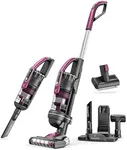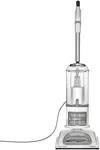Buying Guide for the Best Bagged Upright Vacuum Cleaners
Choosing the right bagged upright vacuum cleaner can make a significant difference in maintaining a clean and healthy home. These vacuums are known for their powerful suction and ease of use, making them a popular choice for many households. When selecting a bagged upright vacuum cleaner, it's important to consider several key specifications to ensure you get the best fit for your needs. Understanding these specs will help you make an informed decision and find a vacuum that meets your cleaning requirements effectively.Suction PowerSuction power is a measure of how effectively the vacuum can pick up dirt and debris from various surfaces. This spec is important because higher suction power generally means better cleaning performance. Suction power is often measured in watts or air watts. For homes with thick carpets or heavy pet hair, a vacuum with higher suction power (around 200-300 air watts) is ideal. For homes with mostly hard floors or low-pile carpets, a lower suction power (100-200 air watts) may suffice. Consider the types of surfaces in your home to determine the appropriate suction power for your needs.
Filtration SystemThe filtration system in a vacuum cleaner determines how well it can trap dust, allergens, and other particles. This is especially important for households with allergy sufferers or pets. HEPA (High-Efficiency Particulate Air) filters are the gold standard, capable of trapping 99.97% of particles as small as 0.3 microns. If you have allergies or asthma, look for a vacuum with a HEPA filter. For general use, a standard filter may be sufficient, but ensure it is easy to replace and maintain.
Bag CapacityBag capacity refers to the amount of dirt and debris the vacuum's bag can hold before it needs to be replaced. This spec is important because a larger bag capacity means fewer bag changes, which can be more convenient and cost-effective. Bag capacities typically range from 1 to 4 liters. For larger homes or those with pets, a larger bag capacity (3-4 liters) is beneficial. For smaller homes or less frequent cleaning, a smaller capacity (1-2 liters) may be adequate. Consider how often you vacuum and the size of your home when choosing the bag capacity.
Weight and ManeuverabilityThe weight and maneuverability of a vacuum cleaner affect how easy it is to use, especially if you have multiple floors or need to carry it up and down stairs. Lighter vacuums (under 15 pounds) are easier to maneuver and carry, making them ideal for those with physical limitations or multi-story homes. Heavier vacuums (over 15 pounds) may offer more stability and durability but can be more challenging to move around. Consider your physical strength and the layout of your home when evaluating this spec.
Cord LengthCord length determines how far you can move the vacuum without needing to switch power outlets. This is important for convenience and efficiency, especially in larger homes. Cord lengths typically range from 20 to 35 feet. For larger rooms or open floor plans, a longer cord (30-35 feet) is ideal to minimize interruptions. For smaller spaces or homes with plenty of outlets, a shorter cord (20-25 feet) may be sufficient. Think about the size of the areas you will be cleaning and the availability of power outlets when choosing the cord length.
Noise LevelThe noise level of a vacuum cleaner can impact your comfort and that of others in your home. Noise level is measured in decibels (dB), with lower numbers indicating quieter operation. Vacuums typically range from 60 to 80 dB. For a quieter experience, especially if you have young children or pets, look for a vacuum with a noise level under 70 dB. If noise is not a major concern, a higher noise level (70-80 dB) may be acceptable. Consider your sensitivity to noise and the times you usually vacuum when evaluating this spec.




















